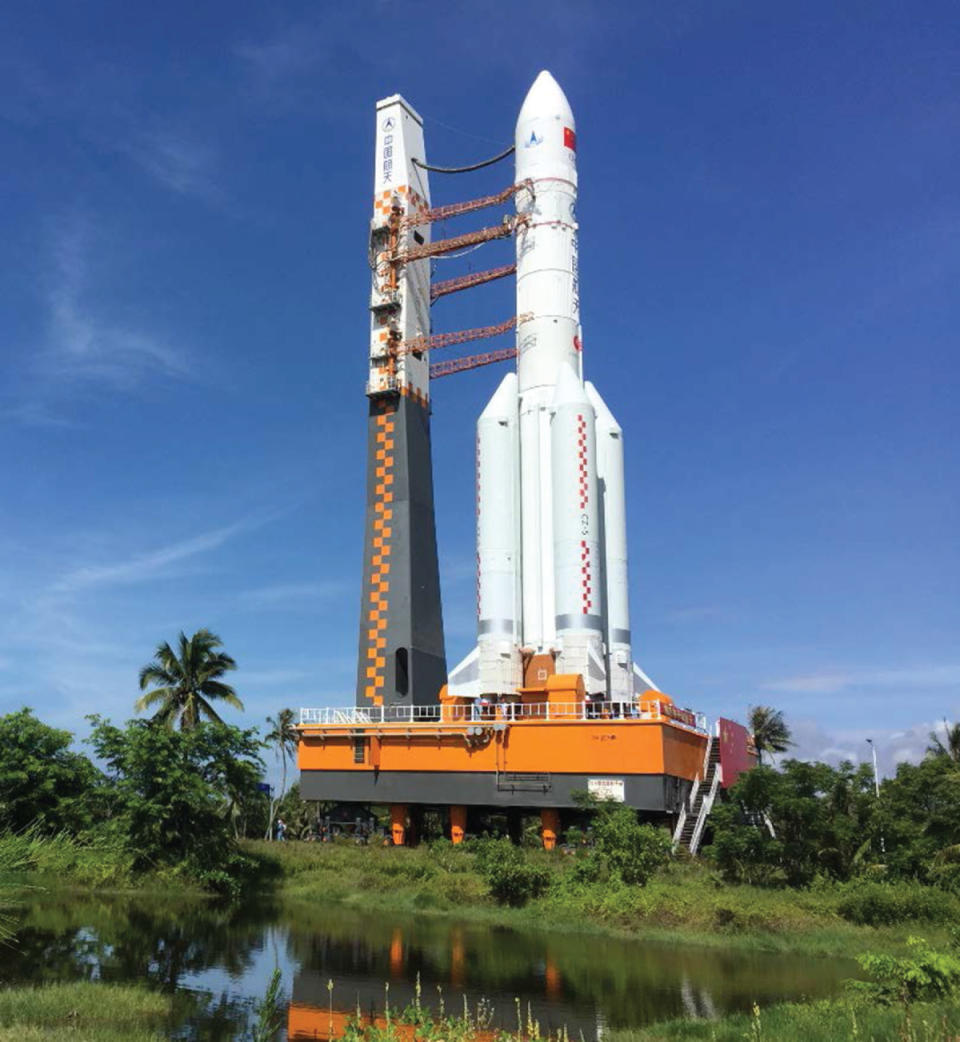Another Chinese rocket booster just crashed back down to Earth

China's National Space Administration is under criticism again, today, after another of their rocket boosters crashed, uncontrolled, back down to Earth.
On October 31, China launched the second module of their new space station into orbit atop a Long March 5b booster rocket. The Long March 5b, or Changzheng 5, is built specifically for boosting large payloads into space, similar to SpaceX's Falcon Heavy, the ESA's Ariane 5, and ULA's Delta IV Heavy rocket used by NASA.

The Long March 5b heavy-lift booster rocket. Credit: Xiaojun Wang, China Academy of Launch Vehicle Technology (CC by 4.0)
In the days since the launch, the space community has been keeping careful watch on the expended rocket. Once it had delivered its payload into space, the booster went into an uncontrolled dive back towards Earth. Although it is a fairly standard practice for expended rockets to fall back to Earth (SpaceX's Falcon 9 and Falcon Heavy being the exception), this case was different.
The orbit of the booster was fairly well known. Each time it circled the Earth, it would swing from 40 degrees north latitude to 40 degrees south latitude. That's roughly as far north as Lake Erie, and down to just south of Australia, which covers a large area of the planet.
The problem was, no one knew exactly where in that area the rocket would eventually fall!
The best the space community could do is track each orbit, and slowly narrow down which orbits were the most likely for it to crash down.
Our latest prediction for #CZ5B rocket body reentry is:🚀04 Nov 2022 11:20 UTC ± 3 hoursReentry will be along one of the ground tracks shown here. It is still too early to determine a meaningful debris footprint. Follow here for updates: https://t.co/KZZ9LgLk0k pic.twitter.com/GlnE8C0Iok
Our latest prediction for The Aerospace Corporation on Twitter: "Our latest prediction for #CZ5B rocket body reentry is:🚀04 Nov 2022 11:20 UTC ± 3 hoursReentry will be along one of the ground tracks shown here. It is still too early to determine a meaningful debris footprint. Follow here for updates: https://t.co/KZZ9LgLk0k pic.twitter.com/GlnE8C0Iok / Twitter" rocket body reentry is:
🚀04 Nov 2022 11:20 UTC ± 3 hours
Reentry will be along one of the ground tracks shown here. It is still too early to determine a meaningful debris footprint. Follow here for updates: The Aerospace Corporation on Twitter: "Our latest prediction for #CZ5B rocket body reentry is:🚀04 Nov 2022 11:20 UTC ± 3 hoursReentry will be along one of the ground tracks shown here. It is still too early to determine a meaningful debris footprint. Follow here for updates: https://t.co/KZZ9LgLk0k pic.twitter.com/GlnE8C0Iok / Twitter" The Aerospace Corporation on Twitter: "Our latest prediction for #CZ5B rocket body reentry is:🚀04 Nov 2022 11:20 UTC ± 3 hoursReentry will be along one of the ground tracks shown here. It is still too early to determine a meaningful debris footprint. Follow here for updates: https://t.co/KZZ9LgLk0k pic.twitter.com/GlnE8C0Iok / Twitter"— The Aerospace Corporation (@AerospaceCorp) The Aerospace Corporation on Twitter: "Our latest prediction for #CZ5B rocket body reentry is:🚀04 Nov 2022 11:20 UTC ± 3 hoursReentry will be along one of the ground tracks shown here. It is still too early to determine a meaningful debris footprint. Follow here for updates: https://t.co/KZZ9LgLk0k pic.twitter.com/GlnE8C0Iok / Twitter"
Related: An out-of-control rocket is hurtling toward Earth, but should we be worried? - The Conversation
On Friday morning, US Space Command confirmed that the booster reentered the atmosphere at around 7 a.m. EDT (4 a.m. MDT). It apparently crashed into the south-central Pacific Ocean.

They later confirmed a second reentry associated with the rocket, in the northeast Pacific Ocean.
Rockets are built out of mostly light materials, which then burn up on reentry into the atmosphere. However, there are some parts that can survive to reach the surface.
Given the uncertainties involved in this incident, we are all lucky that the rocket did not crash down into a populated area.
Related: NASA plans to crash the ISS into the 'spacecraft cemetery' in 2031
Both NASA and the ESA levelled criticism at China's National Space Administration on Friday for what they said was irresponsible behaviour.

"This is the [People's Republic of China]'s fourth uncontrolled reentry since May 2020, and each of these reentries have been the largest in the last 30 years," NASA Administrator Bill Nelson said in an email statement on Friday. "It is critical that all spacefaring nations are responsible and transparent in their space activities and follow established best practices, especially, for the uncontrolled reentry of a large rocket body debris — debris that could very well result in major damage or loss of life."
The head of the European Space Agency, Josef Aschbacher, added his own statement on Twitter, saying: "Today's uncontrolled Long March 5B reentry underlines the growing risk for critical infrastructure both in space and on the ground posed by unsustainable spaceflight practices."
Many types of rocket have the capability to push themselves back down out of orbit. Thus, they can make a controlled reentry and typically splash down in the south Pacific Ocean, in an area known as the 'space graveyard'.
Long March 5b rockets do not have this capability. Once they're expended, they rely solely on gravity and the drag of the atmosphere to pull them down out of orbit. This makes their reentry far more unpredictable.
(Thumbnail image courtesy CASC/Storyful)

